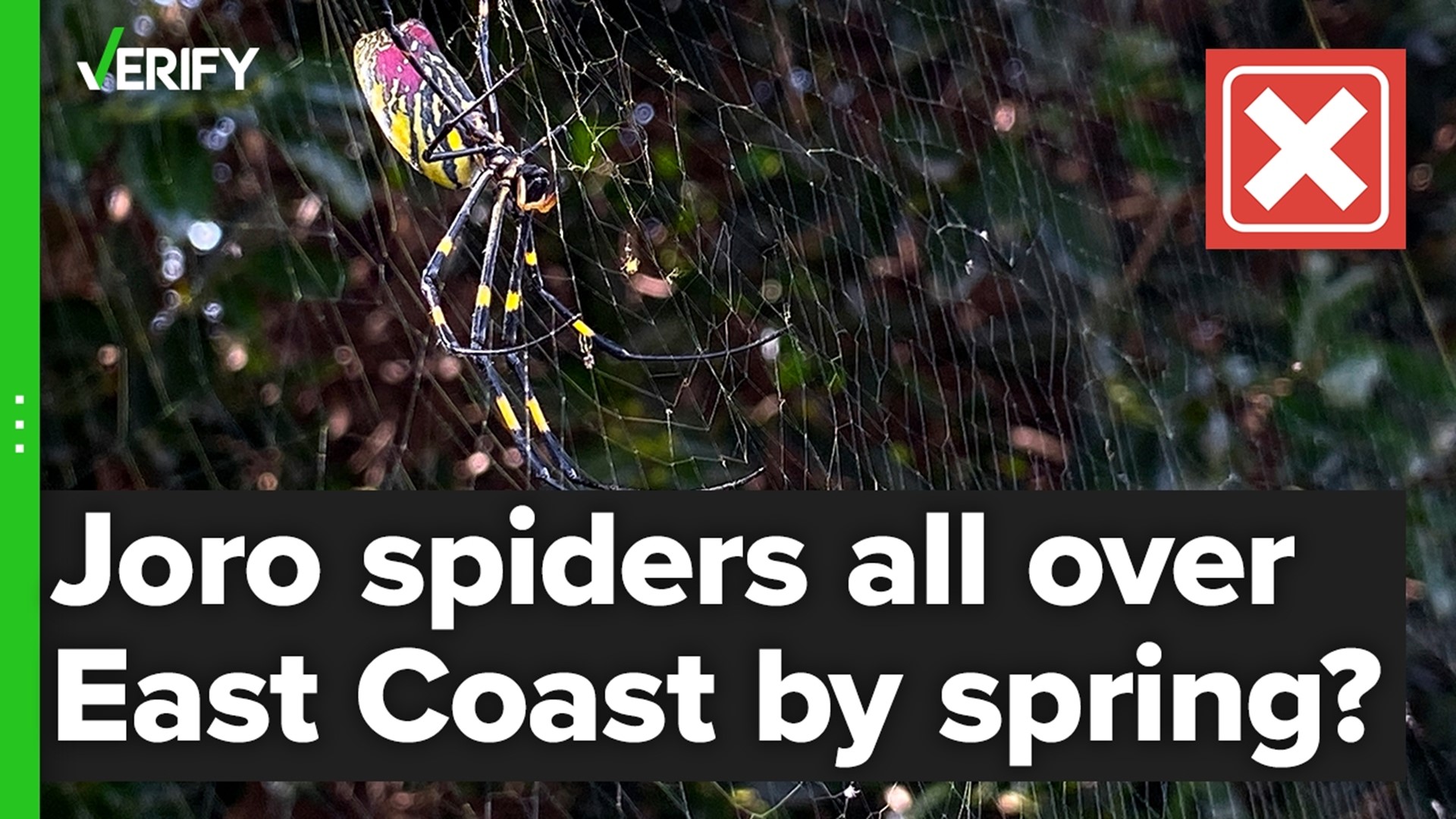Reports of an invasive spider spreading across the entire East Coast are sparking panic for some social media users.
A story published by news website Axios claims that researchers at the University of Georgia recently announced that the Joro spider is “expected to ‘colonize’ the entire East Coast this spring by parachuting down from the sky,” citing research conducted by scientists at the University of Georgia. A tweet with the same information has been quoted more than 20,000 times.
THE QUESTION
Does a study on Joro spiders say they will colonize the entire East Coast by this spring?
THE SOURCES
- Andy Davis, Ph.D., assistant research scientist at the University of Georgia’s Odum School of Ecology
- Study on Joro spiders published by University of Georgia researchers
- Floyd Shockley, Ph.D., collections manager of entomology with the National Museum of Natural History
- Penn State Extension
THE ANSWER
No, a study on Joro spiders does not say they will colonize the entire East Coast by this spring. The study found that the spiders could withstand the Eastern Seaboard’s cooler climate, but it’s unclear exactly when they could arrive in the area.
WHAT WE FOUND
The large, brightly colored Joro spider is native to Japan, Korea, China and Taiwan, but it arrived in the United States around 2013. The spider, which can grow to the size of a person's palm, was first discovered in Georgia and has since made its way to other parts of the southeastern U.S. Experts say the spider has black legs with yellow-orange stripes, a bright yellow body with bluish-green stripes on its back, and red markings on its underside.
Scientists at the University of Georgia suspect that the Joro spider arrived in the U.S. by accident either in shipping containers, among packing materials like pallets and crates, or on live plant material. Since their arrival in Georgia, the spiders have spread into adjacent states, including Alabama, North and South Carolina, and Tennessee.
New research from the University of Georgia suggests that the spiders can survive in cooler areas and could eventually appear in many states along the East Coast. The study, published by the Royal Entomological Society in February 2022, found that the invasive spider “can complete its life cycle within a narrow period of suitable weather.”
The Joro spider has a metabolism that is twice as high as that of a golden silk spider, which is a closely-related species, and a 77% higher heart rate when exposed to low temperatures, the study found. Additionally, Joro spiders survive better in a brief freeze than golden silk spiders.
“These findings suggest the Joro spider can exist in a colder climatic region than the southeastern USA, which can be useful information for management or planning purposes,” the study says.
The last time spider hatchlings emerged was in the spring in Georgia, but that doesn’t mean we know when the Joro spider will arrive in other states on the East Coast. Davis told VERIFY the study “did not address how far the Joros will spread or when they will arrive.” Additionally, the study never explicitly says the spiders will "colonize" the Eastern Seaboard.
You might be asking: How long would it take for the spiders to colonize the entire East Coast? That’s anyone’s guess right now, but experts do believe the spiders are on their way to more eastern states.
“I would say definitely coming," Davis said. "Just a matter of when...that's the real question.”
Floyd Shockley, Ph.D., collections manager of entomology with the National Museum of Natural History, agrees.
"Do I think they're going to get here? Absolutely," he said. "I do think they're going to get this far, and I think with our milder winters, the eggs will survive the winter just fine. But I don't think they're going to ever be a major concern."
Since the spiders can hitch a ride on cars, it is possible that some of them did so last year and may pop up in different states by this summer or fall, Davis said. Shockley says it's possible that the spiders will appear in more states along the East Coast next year.
According to a fact sheet published by Penn State Extension, since their arrival in 2013, Joro spiders have spread outward in all directions from the location where they were initially found by 50 to 80 miles, or about 10 miles per year, between 2014 and 2022.
“At that rate, they may reach southeastern Pennsylvania in 35 years and northwestern Pennsylvania in 60 years,” the fact sheet says. “However, spiderlings are capable of moving tens to hundreds of miles via ballooning, so a storm blowing in the right direction at the right time of year may move them in large jumps.”
Ballooning means the spiders can use their silks to carry them across the wind to new locations.
Regardless, Joro spiders aren’t a cause for panic, as they are “relatively harmless to people and pets,” the University of Georgia says. The spiders won’t bite unless concerned, and their fangs often aren’t large enough to break human skin.
The spider’s venom is also weak, so bites are less painful than a bee sting and only produce localized pain and redness that goes away quickly.
More from VERIFY: Yes, cattle are the top source of methane emissions in the U.S.

